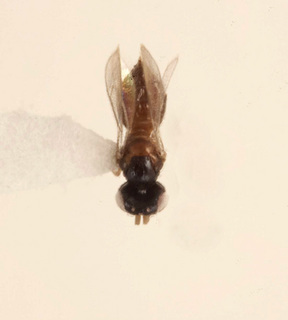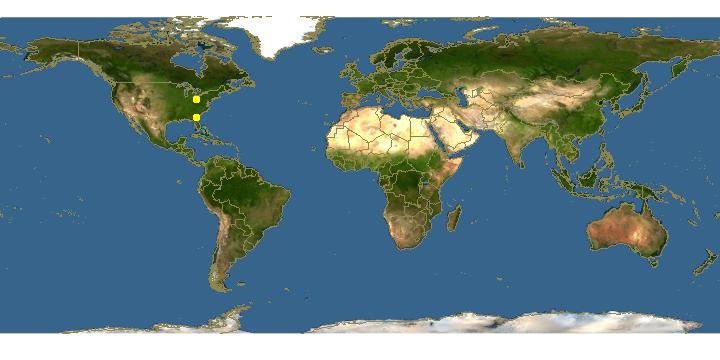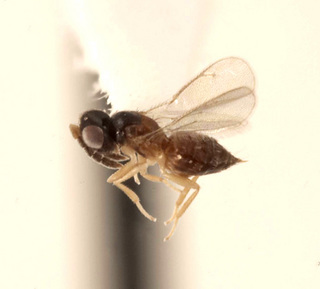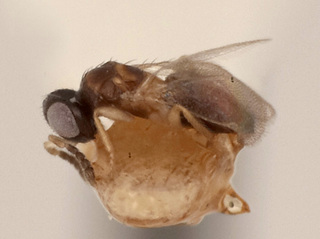
Jaime Fuest, University of Georgia · 0
Tetrastichomyia clisiocampae |

Click on map for details about points.
|
80x5 -
240x3 -
240x4 -
320x1 -
320x2 -
320x3 -
640x1 -
640x2
Set display option above.
Click on
images to enlarge. |

Jaime Fuest, University of Georgia · 0
Tetrastichomyia clisiocampae, lateral |

Jaime Fuest, University of Georgia · 0
Tetrastichomyia clisiocampae, lateral1 |
|
Identification | |
The original species description is presented here in text form taken directly from: Ashmead, W.H. 1894. Descriptions of new parasitic Hymenoptera. Transactions of the American Entomological Society of America 21:318-344.
MIOTROPIS Thomson.
1872.-Hym. Scand. vol. v, p. 197.
(Type M. sulcicrista Thoms.)
Miotropis clisiocampae sp. n.
Female.-Length 1.5 mm. Black, polished; the scutellum and metathorax light brown or yellowish; scape, pedicel, first funicular joint and legs,including coxae,pale yellow, rest of flagellum black ; pedicel very long, as long, or a little longer than the club.
Wings hyaline, pubescent, the marginal vein very long, the
stigmal and postmarginal very short. equal in length. Abdomen orbicular, a little wider than the thorax, with a very short petiole, subsessile.
Hab.-Morgantown, W. Va.
Described from four female specimens bred June 28, 1891, by Prof.
A. D. Hopkins from Clisiocampa americana on apple.
|
|
|
Names | |
Miotropis clisiocampae
|
|
|
Natural history | |
Tetrastichomyia clisiocampae is also a parasitoid on Clisiocampa americana, the American tent caterpillar (Ashmead, 1894). Other hosts include Achatodes zeae (Noctuidae), Porthetria dispar (Lymantriidae), Malacosoma americanum (Lasiocampidae), Diatraea crambidoides (Pyralidae), Ostrinia nubilalis (Pyralidae), Grapholita molesta (Olethreutidae), Microplitis gortynae (Braconidae), and Compsilura concinnata (Tachinidae) (Peck, 1963).
|
|
|
References | |
Ashmead, W.H. 1894. Descriptions of new parasitic Hymenoptera. Transactions of the American Entomological Society of America 21:318-344.
Peck, O. 1963. A Catalogue of the Nearctic Chalcidoidea (Insecta: Hymenoptera).The Canadian Entomology Supplement 30.
Solomon, J.D. 1995. Guide to Insect Borers of North American broadleaf trees and shrubs. Agric. Handbook. 706. Washington, D.C.: U.S. Department of Agriculture, Forest Service. 735p.
|
|
|
Acknowledgements | |
The first and third images are of a specimen captured in Williamsville (Wayne Co.), Missouri in October of 1977. The author gratefully acknowledges Dr. A.M.R. Bennett and the Canadian National Collection of Insects for receipt of this specimen loan.
The second specimen, seen in lateral view was reared from Anacamptodes perogracilis (Geometridae) pupae taken at Pinecrest (Monroe Co.), Florida 5.IX.1980. The author gratefully acknowledges Dr. B. Blinn and the North Carolina State University Insect Collection for receipt of ths specimen loan.
|
|
| Supported by | |
Updated: 2024-04-19 00:24:23 gmt
|